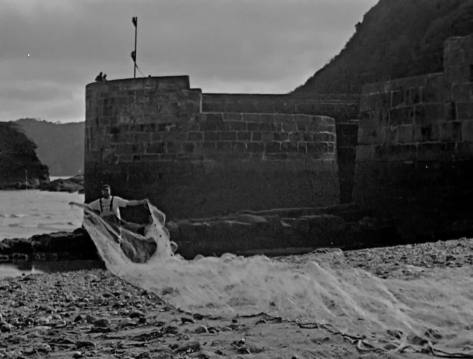It’s a great week for new British cinema. I don’t get to type that very often. But this week, as the heatwave cools, you can spend your cinema money on two fascinating and brilliant new movies by young British filmmakers: Joanna Hogg’s finely polished dissection of a troubled romance, The Souvenir, and Mark Jenkin’s Bait. I highly recommend both*, but it’s Bait I want to talk to you about today.
Bait is Jenkin’s debut feature and it continues the themes and techniques he has explored in his short work. He’s a Cornish filmmaker, and in shorts such as Bronco’s House (2015), he has tackled subjects very close to his own home, the dissolution of the local way of life due to housing shortages exacerbated by unchecked tourism and the loss of traditional crafts and livelihoods. Those themes surface again in Bait, a portrait of a belligerent, bereaved young man called Martin (Edward Rowe) who lives in Newlyn, once a busy fishing port. Martin’s family home has been bought by a middle-class London family who have decked it out with tacky nautical accessories and use it only for holidays and Airbnb income, and his job as a fisherman has also dwindled to a shadow of itself. He no longer has his own boat, and relies on what he can catch from hand-cast nets instead. His brother has a boat, but adding insult to injury, uses it for pleasure cruises rather than the family business. It’s important, not to say simply refreshing, to see British filmmakers bringing regional issues to light in this way. Too many commercial films portray the British countryside as a moneyed idyll or a folksy home for cute eccentrics. Bait doesn’t do that.

The form of the film is what concerns us here though. In 2012, Jenkin wrote a manifesto called Silent Landscape Dancing Grain 13. It’s pretty hardcore. Among other strictures, his films must be shot silently, with post-synched sound, using only natural or available light on small-gauge film, in monochrome with no non-diegetic music. So, no sweeping helicopter shots of the lush Cornish coastline with a ravishing orchestral score then? Definitely not.
I love this manifesto. That’s not to say that all filmmakers should adopt these rules, but I am captivated by the sight of a director deliberately limiting their options, to exploit the essentials of film alone. In an interview in Sight & Sound, Jenkin was talking about the film’s spiritual element, when he said: “There’s something intangible and that’s what film can do that I don’t think any other artform does.” It’s an interesting quote, not least because this film is intensely tangible – more so than any I have seen for a long time.

Shot in 16mm on a 1970s Bolex camera, Bait is speckled with hairs and cracks and grain. Flashes of light leak into the frame; the image is polarized for a few seconds and then resettles. You know you’re watching a film. And then there is the editing. So many cuts, reframing the action into stark, square alienating compositions. Heavy boots on a kitchen floor; a fridge stocked with imported fruit and sparkling wine; a knife; a clenched fist; a dying, drowning fish. The cuts shift us uncomfortably in time as well as space. Flash-forward edits introduce shadows of the violence to come: spilled blood, handcuffs. It’s disorienting, but it should be. Bait is about a way of life under threat, and Jenkin’s film shows us the tourist image of the Cornish seaside splintering. He uses one outmoded craft to tell a story about another: analogue film meets small-scale fishing. A set of twin archaisms, both much fetishized in their own way, but losing support. “Historically, there’s always been a link between the arts world and the world of fishing,” Jenkin told the Guardian last week.
There’s a beauty to these images too, the spirituality that Jenkin was talking about. It’s impossible not to think of some of the most poetic examples of silent cinema, such as Jean Epstein’s Finis Terrae (1929), another violent story with a sublime coastal setting. And the leaden import of some of those cuts recalls another strain of silent film: the politically charged shot-synthesis of Soviet montage.

As the film was shot silent, the dialogue, pasted on afterwards, takes on an unusual quality. It’s an intrusion of sorts, like an intertitle perhaps, but this process allows us to the weigh the words properly. The rows between Martin and the couple who bought his home, or frank exchanges in the local pub burst into the film not as natural conversation but heavily loaded declarations of intent. Take this line from Martin, seething about the cartoonish seaside interior décor favoured by the London family: “All bloody ropes and chains. Looks like a sex dungeon.” It’s more like dialogue remembered than overheard: all punch, no preamble. It’s a strange, and to me unexpected consequence of the silent-shooting approach.
Bait is a fantastic movie, and will intoxicate anyone who loves the art and craft of film. The pacing stumbles a little towards the end, it’s true, but I left the cinema enthralled and full of excitement about the medium. Jenkin proves that there is life in the old ways yet, and everything to gain by going against the grain.
- Bait is released on 30 August
- Read Tara Judah’s fascinating piece on Bronco’s House (2015) for Sight & Sound.
- * If you applied the thumbscrews, I’d have to tell you that I preferred The Souvenir, but the films are both so wonderful, and so different, that in this case, comparisons are certainly odious.
- Silent London will always be free to all readers. If you enjoy checking in with the site, including reports from silent film festivals, features and reviews, please consider shouting me a coffee on my Ko-Fi page

excellent review
Thank you!